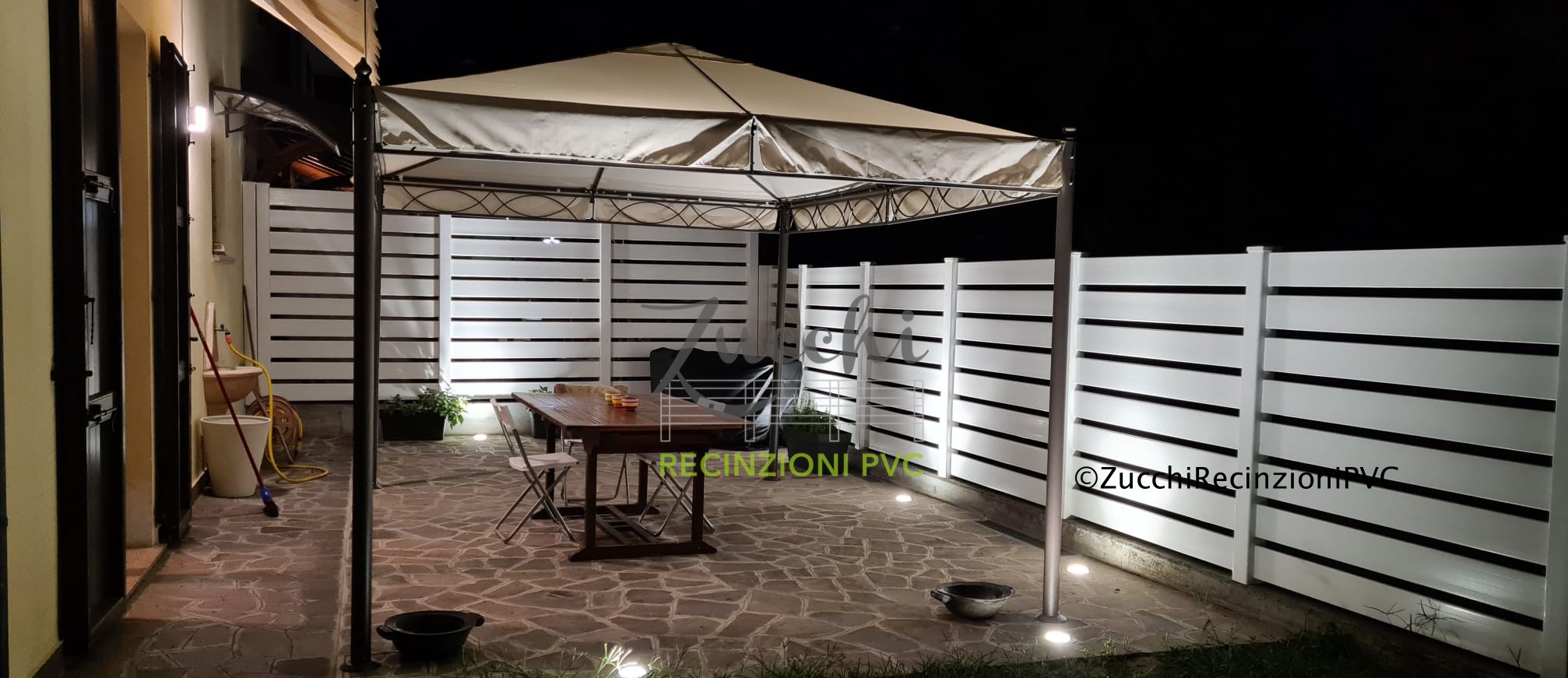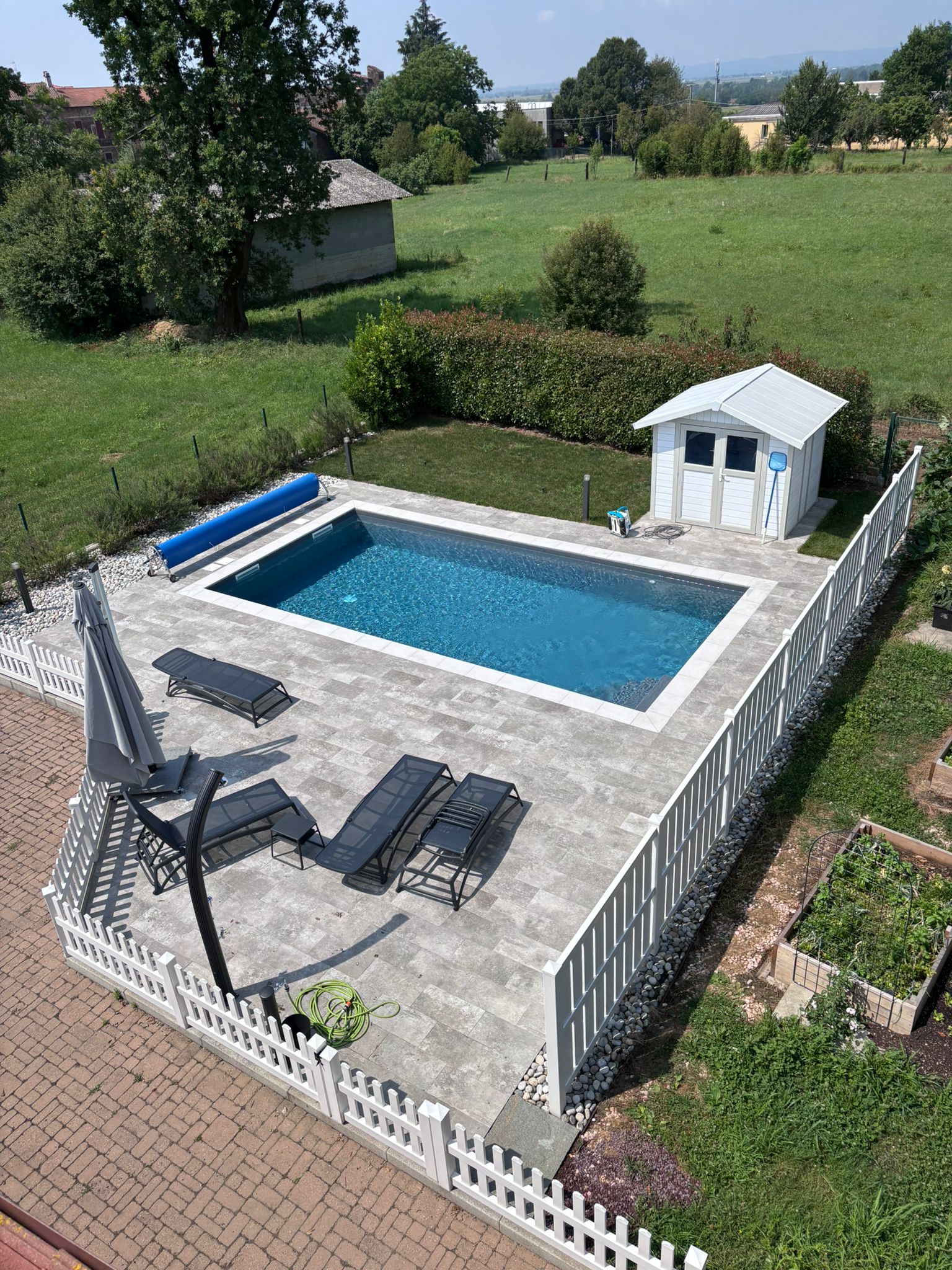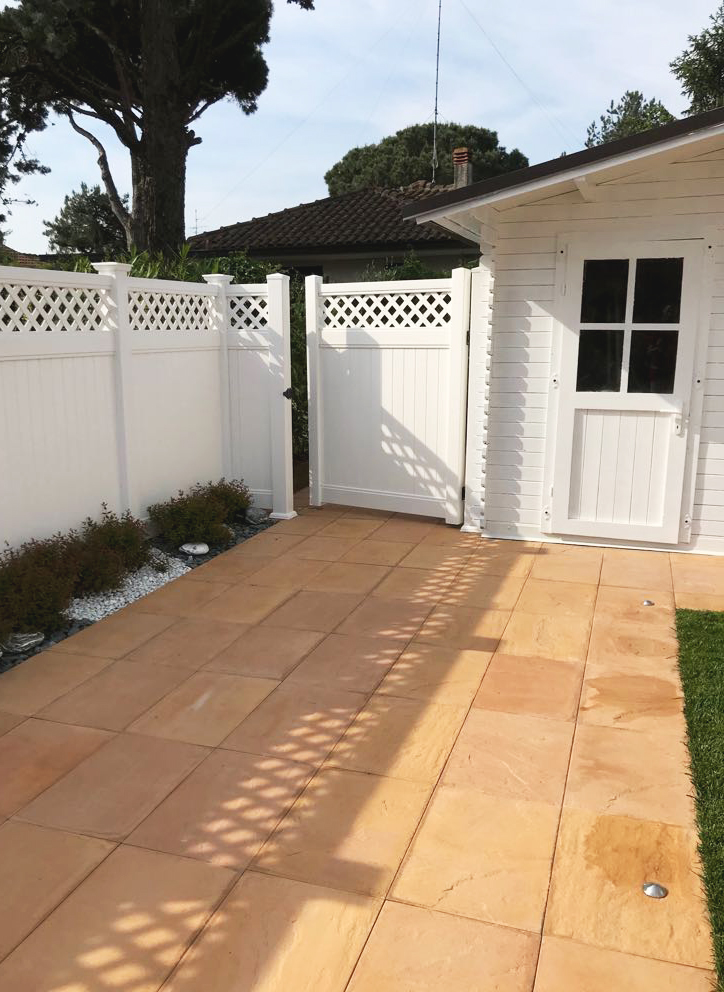Side wind and garden microclimate: practical guide to keep your lawn from getting messed up
Have you ever spent hours tidying up your garden only to see everything ruined by a gust of crosswind?
If yes, know that you are not alone. Wind not only disturbs, it changes the very microclimate of your outdoor space.
And for a designer or craftsman, understanding this means coming up with solutions that are smarter, more effective … and appreciated by the end customer.
In this article we look at how crosswinds affect the garden and how windbreak fences can be a game changer.
All without using technical buzzwords or doing a rain dance.
Crosswinds do more damage than you think
When you think of wind, you probably picture a light breeze or a sudden thunderstorm, but there is a more devious enemy:
the constant crosswind, the one that slowly disturbs plants every day, dries out the soil and makes the air unbreathable.
This type of wind is typical of coastal, hilly or flat areas where the air moves unimpeded for miles.
The result? Plants with bent leaves, suffering blooms, patio chairs flying around like sheets of paper.
And it doesn’t end there. The wind carries dust, sand and debris, changes the humidity of the air and in some cases even the perceived temperature.
Basically, it creates an artificial microclimate that can make a green corner look like a battlefield.
So no, it’s not just a matter of annoyance-it’s a design issue that you can solve before it becomes a serious problem.
Windbreak: an invisible (but very powerful) barrier
This is where the windbreak, your new silent ally, comes in.
Yes, because it does not just “block the air,” but regulates the way the wind enters and moves through the garden.
A good windbreak fence should not be an impenetrable wall (that makes things worse by creating turbulence).
Rather, it must filter and divert the flow of wind, reducing its strength but allowing the necessary air to pass through.
In doing so, it helps to:
- Protect the most delicate plants, especially those with large leaves and exposed flowers
- Maintain soil moisture longer, reducing the need for irrigation
- Avoid soil erosion, especially in vegetable gardens or raised beds
- Creating greater comfort for those who live or work outside
In practice, installing a well-designed windbreak is like putting a pair of sunglasses on your garden:
doesn’t change the light, but it enhances the whole experience.
How to orient the windbreak to maximize the effect
Installing a windbreak is not just about “placing it where it is windiest.”
There are simple design strategies you can use to make it make the most of it, and your clients will thank you.
First thing: study the dominant wind direction in the area (there are weather apps that do this in 5 seconds).
Once you know where it is coming from, you can orient the barrier to cover the most exposed area, such as a terrace or sitting area.
Second, don’t overdo the height. A windbreak that is too tall also blocks light and creates unwanted areas of shade.
Better is a medium height (1.5 to 2 meters) and perhaps supplemented with climbing plants, which add aesthetics and additional protection.
Third thing: avoid enclosing everything like a bunker.
Always leave a space for air circulation to avoid the “bellows” effect, which can push air to swirl inside.
Finally, choose materials that are durable and easy to install: treated wood, galvanized metal or technical panels with wood effect.
The result is professional, functional and also beautiful to look at.
More comfort, fewer complaints: happy customers, relaxed craftsmen
Do you know what happens when a client enjoys his garden without feeling at the mercy of the wind?
What happens is that he calls you back, recommends you to friends and maybe entrusts you with other jobs.
Because you solved a problem that no one had ever really taken seriously.
The windbreak, in this sense, is a solution that is small on the outside but huge on the inside.
It is not a decorative object, but an intelligent technical intervention that improves the quality of outdoor life.
If you are a craftsman or building designer, incorporating this type of element into your projects gives you an edge.
It is a way to stand out, to offer solutions that are not only “built well,” but thought through.
Besides, let’s face it: nothing beats the satisfaction of seeing a customer sitting quietly on his patio,
while the wind tries (in vain) to ruin his appetizer.
Outdoor privacy: how to create private and cozy spaces
Have you ever had that nagging feeling of being watched while enjoying a coffee in the garden or reading a book in the shade?
Or are you a craftsman who has heard the customer complain a thousand times about overly curious neighbors or the crosswalk behind the house?
In today’s world, outdoor privacy is no longer a luxury.
It is a real need for both private homes and tourist facilities.
And if you can solve it intelligently, you are doing more than just installing a fence.
Privacy: when the eyes of others are too many
In residential areas, especially in neighborhoods with townhouses or adjacent gardens, privacy becomes a real battleground.
The curious neighbor, the dog barking as soon as he sees you, the children peeking in during the Sunday barbecue-sound familiar?
But even in tourist facilities – such as agritourisms, B&Bs or vacation homes – the issue is even more sensitive.
Those who choose a rental house want to relax without feeling exposed or observed by strangers every time they move.
On vacation, privacy is sacred: no one wants to feel like they are being showcased while sunbathing on the terrace.
That’s where smart design of outdoor spaces comes in.
It’s not enough to “plant two hedges” or “pull up a net”-you need something beautiful, functional, and tailored to people.
Windbreak = elegant (and functional) privacy barrier
Windbreak fencing is not just for air blocking: it can be a perfect ally for creating a private outdoor area.
You’re not closing a space, you’re protecting moments. And that goes double if you’re working for demanding clients.
Unlike classic blind fences, a well-designed windbreak filters the view without weighing down the environment.
It can consist of wood panels, perforated metal, grating with creepers, or technical materials with modern designs.
The great thing is that you can modulate height, length, and structure according to space, display, and-why not-even style.
Because a barrier doesn’t just have to work: it also has to please those who look at it every day from the living room.
Imagine a customer who can finally enjoy breakfast on the patio without crossing his neighbor’s eyes.
Or a tourist relaxing in the B&B’s mini-pool without feeling like they’re on a reality TV set.
It’s those little details that make all the difference in everyday life and five-star reviews.
Designing privacy: practical ideas to come up with now
If you are a craftsman or designer, you can use the windbreak to enhance spaces and solve concrete problems.
Here are a few ideas to suggest to the next client who tells you, “I’d just like a little more privacy.”
- Separate shared spaces with lightweight windbreak panels, perfect for gardens with multiple dwellings or common areas in residences
- Creates screened relaxation areas, such as reading nooks, solariums or small outdoor lounges, also ideal for hospitality facilities
- Protect low windows or balconies with elegant vertical solutions that let light in but not glances out
- Integrate the windbreak with green elements: wooden grating and climbing plants transform the barrier into a decorative element
Remember that versatility is everything: a good windbreak fits every type of client, budget, and context.
And when you can combine aesthetics, functionality and privacy–well, you’ve hit the jackpot.
More privacy, less stress: happier clients, jobs that sell themselves
When a client feels that he or she has “his or her own space,” the perception of the house or facility changes completely.
It is no longer just a physical place: it becomes a refuge, an oasis, a place where you really feel good.
And you, as a craftsman or designer, have the opportunity to create this feeling with just a few clever tricks.
You don’t need complicated structures or super expensive materials, just good design and quality products.
The result? A customer who enjoys the peace of mind, who recommends you to others, and who – maybe – calls you again.
Because you have solved something that everyone notices, but few really know how to deal with.
So yes, the next time you hear the phrase “I’d like a little more privacy,” you will know exactly what to propose.
And you’ll do it with style, efficiency and a good dose of satisfaction.
Vegetable gardens and green corners: how to defend them with style (and intelligence)
Have you ever seen a vegetable garden growing lushly, only to find it half bent after a week of high winds?
Or maybe you have a customer who is proud of his flower beds but complains that he has to pick up spilled pots every night.
It happens more often than you think, especially in windy, exposed areas or areas with few natural shelters.
The good news? There is a simple, beautiful and functional solution: the windbreak fence.
It not only protects, but helps create a more stable microenvironment where plants and vegetables can really perform at their best.
In this article you will find out why gardens love smart barriers, how to place them, and what to recommend to your greener customers.
Plants don’t talk, but they show you when they suffer
When you install a fence or design an outdoor space, don’t just think about walls and tiles-there are also plants.
And, believe it or not, they have very specific needs-even if they don’t talk to you (thankfully).
Dry winds can dehydrate leaves, break young branches or completely stunt the growth of sensitive vegetables.
In some parts of Italy, one windy afternoon is enough to ruin weeks of work in the vegetable garden or greenhouse.
Even ornamental plants, such as flowers or decorative hedges, can be affected by temperature changes caused by sudden draughts.
In short, it is not just an aesthetic issue, but a real functional issue.
And this is where you, the designer or installer, come in, who can make a difference with a solution that is as simple as it is effective.
Windbreak: the silent shield of the garden
A well-placed windbreak does not block the wind completely, but it slows it down, deflects it, and makes it less aggressive.
Just like a natural hedge, but with more control, faster installation and less maintenance.
By installing it near a vegetable garden, greenhouse or flower bed, you create a protected microclimate that promotes plant growth.
Soil dries out less quickly, leaves remain intact, and plants grow stronger and more productive.
Another benefit? You reduce the transport of dust, sand and wind-blown insects, which often damage leaves and shoots.
And you do all this with a structure that is lightweight, aesthetic and adaptable to all kinds of settings.
Whether you are working on a private villa, a farm or a school with a teaching garden, the windbreak is a trump card.
How to choose and place the right windbreak
Not all windbreaks are the same, just as not all gardens have the same needs.
The key is to observe the context well and design intelligently.
First, figure out where the prevailing wind is coming from: a compass or weather app is enough to get a good idea.
Then assess the exposure of the vegetable garden: is it in the sun all day? Does it already receive some shelter from a wall or hedge?
At that point you can decide on height, length and materials.
For vegetable gardens and green areas, best to use semi-transparent or perforated materials that protect without blocking sunlight.
Treated wood, perforated metal panels or technical composites are good solutions, also from an aesthetic point of view.
In addition, you can enhance the barrier with climbing plants or vertical blooms, so as to combine functionality and beauty.
Last practical tip: Do not close the space completely, but leave a few strategic openings for air to circulate.
Protecting the green is adding value (and customers are noticing)
When you protect vegetable gardens, planters or small greenhouses, you are doing more than installing a fence.
You are valuing nature and the work behind it, whether it is by a passionate retiree or a sustainable agritourism.
And you know what the nice thing is? That the clients notice right away.
They see that the wind is no longer doing damage, that the plants are better off, and that their green space is really livable.
These are the details that turn a simple job into an accomplishment that speaks for itself.
And that gets you into the circle of “trusted” suppliers or installers.
Plus, when solutions are beautiful to look at, sturdy and practical, you don’t need a thousand words to sell them.
All it takes is a walk around the garden and a satisfied customer telling you, “This is really nice, thank you!”
Courtyards always clean? Yes, with the right windbreak
You know those windy days when it seems like every leaf in the neighborhood decides to land in your yard?
Or those situations where sand, dust, and debris invade the outdoor space, even after you have just cleaned it?
If you are a designer or craftsman, you know how common this annoyance is.
Clients ask you for a solution, often tired of spending hours sweeping, every time there is a whiff of air.
But here’s the good news: there is a smart and lasting way to limit the dirt that the wind brings into the yard.
Just install a well-designed and thoughtfully placed windbreak fence. And there’s no need to reinvent the wheel.
Wind is not always welcome in your outdoor space
Wind can be pleasant in summer, but it often turns into a means of transport for all kinds of unwanted dirt.
Especially in areas near the sea, fields or unpaved roads, the wind brings with it sand, leaves and debris.
Dust settles on furniture, fixtures and floors, while dry leaves and litter accumulate in corners.
The result? A yard that looks neglected, even though you cleaned it the day before, complete with a blower.
And if we are talking about tourist facilities, such as B&Bs or agritourisms, the effect is even more noticeable (and annoying).
No customer wants to find dirty chairs, dusty floors, or leaves on the plate during breakfast outdoors.
Fortunately, this can be limited in a simple way by acting at the root of the problem: cross and direct wind.
Windbreak: less draft = less dirt around
Installing a well-designed windbreak allows the wind to slow down before it can come in and “blow everything away.”
It is not about blocking the air as if it were concrete, but about filtering it, slowing it down and guiding it intelligently.
In this way, you prevent dust, leaves, sand and other light debris from being carried en masse into the yard.
The microclimate remains more stable, more pleasant and definitely easier to keep clean.
Whether you are working in a private home, a condominium garden, or a hospitality facility, the concept does not change.
Less wind = less dirt. And less dirt = happier customers and less maintenance.
In addition, many modern windbreaks are designed to be easy to install, aesthetically pleasing, and integrable with outdoor furniture.
In short, not only functional, but also beautiful to look at (which never hurts).
How to choose the ideal windbreak for clean yards
Every space has its own characteristics, so the right solution always starts with a good analysis of the context.
As a craftsman or designer, you are the one to guide the client in making the best choice, based on where the yard is located and what surrounds it.
If the yard is next to a dirt road, the main problem will be dust.
If, on the other hand, it borders a field, it will be the leaves, insects and windblown litter that will be a nuisance.
In such cases, it is best to opt for semi-blind windbreaks, perhaps made of durable, easy-to-clean materials such as perforated metal or technical PVC.
They are durable, undemanding and often modular as well, perfect to fit any type of outdoor area.
Another practical tip? Place the windbreak in the most exposed areas, without completely closing off the yard.
The goal is to create a “smart” barrier, not a wall that traps air. That way the environment remains airy, but much cleaner.
And if you want to add an aesthetic touch, you can combine it with pots, vines or LED lights for a guaranteed wow effect.
Tidier yards = more satisfied customers
Often your clients don’t even know that you can reduce outdoor clutter by taking action on the very wind.
But when they see the change, they thank you. Because they can finally enjoy the outdoor space without having to clean it every other day.
And for you, whether you install or design, this translates into more perceived value, more word-of-mouth and more future requests.
It is a simple but effective way to make a difference from the competition without the need for major works.
Every yard that stays tidy with little effort is a small victory.
And every customer who enjoys their yard without having to chase leaves is a customer who will keep you in mind.







Leave A Comment